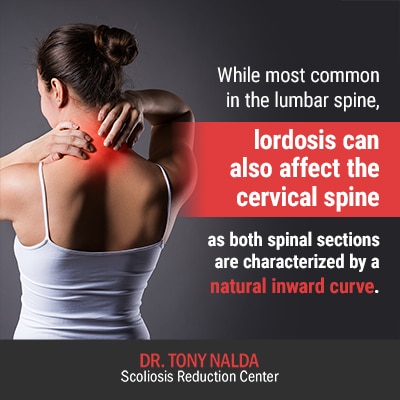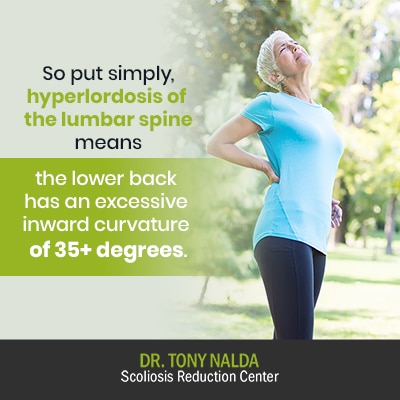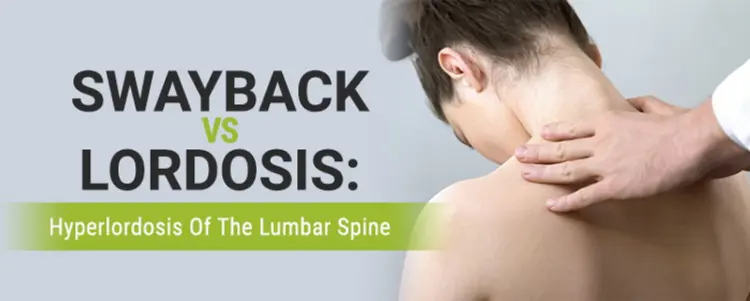The spine has different types of curvatures, some that bend inwards towards the body’s center, and some that bend outwards, away from the body’s center. The spine’s natural and healthy curvatures make it stronger, more flexible, and help it evenly distribute mechanical stress. There are a number of spinal conditions that cause a loss of these healthy curves, such as lordosis, characterized by an excessive inward curvature, most commonly, of the lumbar spine.
When the spine’s inward curvature is exaggerated, the condition is medically known as ‘lordosis’, and the term ‘swayback’ is its colloquial equivalent. Lordosis most commonly develops in the lumbar spine (lower back), and as the spine curves too far inwards, it can result in postural deviation.
Before we move on to the specifics of lordosis and/or hyperlordosis, let’s first work towards a more complete understanding of the spine’s structure by touching on some basic spinal anatomy.
Anatomy of a Healthy Spine
The spine has three main sections: cervical (neck), thoracic (middle and upper back), and lumbar (lower back), and each section is characterized by its healthy and natural curve.
When viewed from the side, a healthy spine has a soft ‘S’ shape, and when viewed from the front, it will look straight.
As mentioned, the spine’s healthy curves enable its optimal function by making it stronger, more flexible, and help to evenly distribute mechanical stress that’s incurred during movement; they also help the spine stay aligned by maintaining its natural curvatures.
When one of these natural curves are lost, however, the spine responds by putting in unhealthy counteractive curves, and this disrupts the spine’s biomechanics and impairs its ability to maintain those healthy curves.
‘Kyphosis’ refers to the spine’s curvatures that bend outwards, while ‘lordosis’ refers to curvatures that bend inwards.
As the lumbar and cervical spine curves inwards naturally, lordosis can affect either of these spinal sections, but most commonly affects the lower back. As the spine develops an over-pronounced inward curve, this can cause the abdomen to protrude more and the pelvis to curve back and up.
Now that we have explored the role of the spine’s natural curves, let’s talk more about the individual parts that make up the spine, and the roles they play in maintaining its healthy alignment.
Vertebrae and the Intervertebral Discs
The spine is made up of individual bones called vertebrae. Healthy vertebrae are rectangular in shape and are stacked on top of one another in a healthy alignment.
The bones of the spine are separated only by intervertebral discs. They sit between adjacent vertebrae and consist of a tough outer layer and a soft gel-like interior.
The intervertebral discs provide cushioning for the vertebrae by preventing them from rubbing up against one another, causing friction during movement. Their tough outer layer gives the spine structure by holding its parts together, and their malleable interior allows for slight movement of the vertebrae.
The discs act as the spine’s shock absorbers and promote the even distribution of mechanical stress so no one portion of the spine is exposed to adverse spinal tension and uneven wear.
If the vertebrae and discs are healthy, the spine can easily maintain its natural curvatures, but if these parts of the spine face degeneration or are impacted adversely by a spinal condition, such as lordosis, the spine’s overall health, biomechanics, and its ability to maintain its natural curves is impaired.
Now that we have talked about the parts of the spine and how they work together to maintain its natural curves, let’s define lordosis and how it affects the spine.
What is Lordosis and Hyperlordosis of the Lumbar Spine?
There are a number of spinal conditions that can develop, including those that cause a natural curve to become over-pronounced, such as lordosis, that causes an excessive inward curvature of the spine.

While most common in the lumbar spine, lordosis can also affect the cervical spine as both spinal sections are characterized by a natural inward curve.
A normal lordotic curvature range of the lumbar spine is between 20 and 25 degrees, while a normal lordotic curve of the cervical spine is between 20 and 40 degrees.
As you can see, there is a range of normalcy for the spine’s natural lordotic curves, but when a curve falls beyond this normal range, problems can occur.
A measurement of less than 20 degrees in the cervical spine is deemed ‘hypolordotic’, while curves that are larger than 40 degrees are considered ‘hyperlordotic’.
A measurement of less than 20 degrees in the lumbar spine is also deemed ‘hypolordotic’, and lumbar curvatures that are over 35 degrees are considered ‘hyperlordotic’.
So put simply, hyperlordosis of the lumbar spine means the lower back has an excessive inward curvature of 35+ degrees.
When a curvature is over-pronounced, these are atypical spinal curves that place extra stress on the spine, its joints, discs, and surrounding muscles.
In addition, proper vertebral alignment is not possible unless all of the spine’s curves are in the normal range.
Just as there are different types of curvatures that can develop, there are different severity levels. While every case is different, generally speaking, the more beyond the normal range a curvature is, the more severe the condition is, and the more likely it is to produce noticeable symptoms such as pain and postural deviation.
In addition to different severity levels, there are also different types of lordosis that can develop.
Types of Lordosis
There are different types of lordosis a person can develop, with different condition characteristics, causes, and treatment needs.
The 5 main types of lordosis are postural, congenital, traumatic, post-surgical hyperlordosis, and neuromuscular lordosis.
Postural Lordosis

Postural lordosis is the most common form and is often caused by obesity and a lack of muscle conditioning in the back and stomach areas.
It’s not just the individual parts of the spine that play a role in maintaining its healthy curves; it’s also the muscles that closely surround the spine that help provide it with support and stabilization.
When a person is carrying excessive weight in the stomach area, it shifts the back forward, and when the muscles of the back and stomach are weak, they can’t provide the spine with adequate support, while the forward-pull from the excess weight causes the spine to abnormally curve forward.
When a condition is classified as ‘postural’, this means it is not structural, so is less challenging to treat than other forms caused by structural abnormalities.
Congenital Lordosis
In congenital lordosis, infants are born with the condition. This can be caused by malformations in the vertebrae of the spine, causing the affected bones to become weak, misshapen, and the development of abnormal spinal curvatures.
Congenital lordosis can also be caused by an inherited condition called ‘achondroplasia’, related to problems with spinal development that stem from issues affecting cartilage growth.
Traumatic Lordosis
In cases of traumatic lordosis, the spine develops an abnormal curvature because of trauma experienced by the spine.
This is commonly caused by car accidents, falls from high places, and/or sports injuries. Sometimes, there can be issues with the strength of the spine’s connecting links (pars), and if they are weak due to a fracture or the existence of another spinal condition such as osteoporosis, these links can easily break.
It’s not uncommon that when these weakened links are exposed to repeated stress and impact, such as in sports, a spondylolisthesis can occur, which is a break in bone connection.
When the bones of the spine are weak, they are more prone to injury, and adverse trauma can lead to the development of lordosis as it can cause the vertebrae of the spine to slip forward, becoming misaligned, and resulting in an excessive lordotic curve.
Post-Surgical Hyperlordosis
Post-surgical hyperlordosis occurs when a surgical procedure, such as laminectomy, makes the spine less stable.
A laminectomy involves the removal of parts of the vertebrae. This is done to increase access to the spinal cord and/or nerve roots. When the procedure involves multiple levels of the spine, it can cause the spine to become unstable, increasing the spine’s normal lordotic curve to a hyperlordotic curve.
This is most commonly observed in children facing surgery to remove spinal cord tumors.
Neuromuscular Lordosis
Neuromuscular lordosis is caused by the presence of a larger neuromuscular condition/disease such as muscular dystrophy, cerebral palsy, or spina bifida.
In neuromuscular conditions, there is a disconnect between the brain and the muscles that provide the spine with support and stabilization.
There are many different conditions and resulting spinal problems that can occur when there is a larger neuromuscular issue causing their development.
Now that we have talked about basic spinal anatomy, defined lordosis and hyperlordosis, and touched on the most common condition types, what are some of the symptoms that an exaggerated lordotic curve can cause?
Lordosis Symptoms
While every case is different based on a number of patient and condition characteristics such as patient age, condition severity, and condition type, the most common visual symptom of lordosis is an exaggerated inward curvature of the spine, most commonly the lumbar spine, but it can occur in the cervical spine as well.
When an excessive lordotic curve develops in the lumbar spine, it commonly causes the buttocks and abdomen area (stomach) to be thrust forward, making them stick out excessively.
People with lordosis can find it difficult to lie flat on the floor because of their excessively curved spine.
Again, while every case is different, lordosis tends to cause postural deviation without a lot of other noticeable symptoms, especially in mild forms.
In severe forms with larger lordotic curves, however, symptoms can also include:
- Back pain
- Neck pain
- Radiating pain felt in the legs and feet
- Sensations of tingling and/or numbness
While many assume spinal conditions, especially those with the potential to cause noticeable postural deviation, would automatically be painful, that is not always the case, so let’s say a few words about pain, condition severity, and patient age.
One of the biggest challenges to treating a number of spinal conditions is how much they vary from one patient to the next. Lordosis and hyperlordosis can range greatly in severity with mild forms causing almost no noticeable symptoms, and severe forms having the potential to cause substantial postural deviation and varying levels of pain.
In general, the larger a lordotic curve is, the more likely it is to produce noticeable visual changes and produce related symptoms such as back and/or neck pain (depending on its location).
Patient age also plays a huge role in determining whether or not a spinal condition will be painful. In children and adolescents, lordosis, along with other spinal conditions, are not known to be overly painful; this is because younger patients have not yet reached skeletal maturity, but why is that important?
In patients who are still growing, their spines are constantly experiencing a lengthening motion, and that lengthening motion counteracts the compressive force of the abnormal curvature.
In adult patients who are no longer growing, their spines have settled due to maturity and gravity. An abnormal spinal curvature causes compression felt by the spine and its surrounding vessels, muscles, and nerves, and in a spine that’s no longer growing, it is vulnerable to the curvature’s compressive force, and related pain it can cause.
So you, or someone you love, has lordosis: what happens now? Let’s move on to discuss lordosis treatment options.
Lordosis Treatment Options
When it comes time to treat lordosis, different factors will play into the crafting of an effective treatment plan: patient age and overall health, condition severity, curvature location, and type.
As spinal conditions like lordosis and hyperlordosis are highly specific, treatment plans should be customized to address important patient and condition characteristics.
Here at the Scoliosis Reduction Center®, I rely on an integrative and functional treatment approach that prioritizes the spine’s overall health and function.
I combine multiple treatment disciplines for the best results: chiropractic care, in-office therapy, custom-prescribed home exercises, and specialized corrective bracing.
The aforementioned treatment disciplines are the cornerstones of my approach as I can easily customize, modify, and adjust treatment plans as necessary to address the specifics of any patient’s condition.
However, in forms of lordosis that are structural, I, first and foremost, work towards impacting the condition on a structural level, and include working on increasing core strength so the spine has stronger surrounding musculature.
When it comes to postural lordosis, as the condition is not structural, it is highly treatable. In most cases, if the lifestyle issue, such as obesity is addressed, the spine’s natural lordosis can be restored.
In addition, some lordosis-specific exercises and in-office therapy can also be part of an effective treatment plan.
In cases of congenital lordosis, we know they are mainly caused by structural abnormalities of the spine.
While treating infants and young patients comes with its share of challenges, I have experience treating patients of all ages.
Again, while every case is different and treatment needs depend largely on condition severity, generally, I can modify my integrative approach to ensure its effectiveness for younger patients.
I can take some of the same treatment disciplines I rely on in treating lordosis in older children and teens, and modify them comprehensively, to account for the unique needs of treating infants; this can involve monitoring the condition for progression via regular physical examination and X-ray scans, when needed, corrective bracing, and lordosis-specific therapy.
When it comes to treating cases of traumatic lordosis, effective treatment will be guided by the injury that led to the abnormal curvature and will focus on strengthening the spine and its surrounding muscles to provide it with better support and stabilization.
In post-surgical lordosis patients, again, treatment will depend on the surgery that preceded the condition’s development. In general, treatment can include chiropractic care, in-office therapy, and custom-prescribed home exercises.
My neuromuscular lordosis patients can be challenging to treat because there is a larger medical issue at the root of the spine’s excessive lordotic curve. In these types of cases, the underlying neuromuscular condition has to be the driving force of treatment, complicating the treatment process.
Regardless of condition severity or type, there is always the possibility that proactive treatment can bring about improvement, both in terms of a curvature reduction and a stronger more functional spine.
Conclusion
While the spine has natural and healthy curvatures that we rely on to maintain the spine’s strength, flexibility, and maintain good posture, it can also develop unhealthy curves for a variety of reasons.
‘Lordosis’ is the term that describes a spine’s inward curvatures, but the term also refers to the condition that develops when an inward curvature becomes excessive. Hyperlordosis refers to an excessive inward curvature of the spine (either cervical or lumbar) that measures at 35+ degrees.
There are different types of lordosis a person can develop including, but not limited to, postural, congenital, traumatic, post-surgical, and neuromuscular lordosis.
While other factors determine the best possible treatment approach such as patient age and condition severity, condition type is always important as the condition’s underlying cause has to be the driving force behind any effective treatment plan.
Here at the Scoliosis Reduction Center®, I offer patients the benefit of multiple treatment disciplines for a fully-customized treatment approach.





